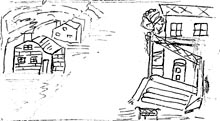
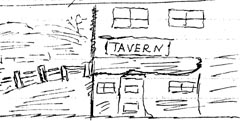
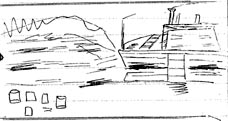
 |
 |
 |
| While George Aiken's 1852 dramatization provided the basis for most
of the thousands of productions of Uncle Tom's Cabin that were staged
every year from the 1860s through the 1920s, it was probably never performed
exactly as printed in the "French's Standard Drama" text that was first
published in 1858. Every company adapted Aiken's script to suit their own and
their audience's taste, adding business, cutting lines, re-arranging scenes, and
so on. A very partial record of those revisions is preserved in the yellowing promptbooks archived in various collections around the country. Accessible here is one of three promptbooks in the New York Public Library for the Performing Arts. It is unsigned and undated, but was clearly used in one of the larger "Tom Shows" (it includes, for example, a donkey for Marks to ride and a horse for Legree), and probably around 1900 (Marks' crude joke about "colored troops" at the end of Act 7, Scene 3 -- a line I haven't seen in any other "Tom Show" script -- sounds like a topical reference to various representations of the behavior of African American soldiers during the Spanish-American War). Like many other promptbooks, it consists of the pages from French's published text pasted into a booklet with interleaved blank pages. The blank pages allowed the manager to make notes about revisions, stage business, music cues, or even (as above) drawings of sets. These directions were keyed to the published text on the facing pages by a series of symbols, as you can see from the image below left. In our electronic text, these notes are moved into the main text, indicated by a # and boldface type. Shorter revisions made directly on French's pages can be identified by the absence of typographical features like SMALL CAPITALS and italics. |
|
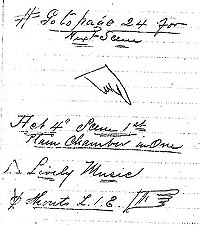 |
Like most promptbooks, this text gets us closer to the "UTC" that 19th century American audiences actually witnessed than any published text. It contains a number of notable features. As you can also see from the notes left, this production made several large structural revisions to Aiken's play, including cutting both scenes at Ophelia's in Vermont, and combining and re-ordering other scenes (on the table of contents below, the original Aiken ACTS.SCENES are noted in parentheses). Aiken's play had 6 acts. Many "Tom Shows" cut that to 5, but this is the only 7-act version I've come across. The extra act is II, Panorama of the Mississippi. In some productions there was an actual "panorama," a representation of river scenery painted on a long strip of canvas backdrop that was unrolled to create a primitive illusion of a boat moving down river. That doesn't seem to be the case here, but although no pages seem missing, it's hard to see what (besides an occasion for the African American singers to perform) this Act II involved. |
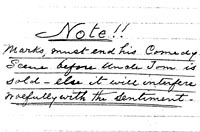 |
Also like most "Tom Shows," many of the original text's emphases on religion and racial prejudice are shortened or cut, while every occasion for humor is played up. The note left is from the elaborate rewrite of the Auction in Act 6; the "comedy scene" involving Marks' bidding is one you can find in many contemporary scripts (and the 1903 film). On balance this is a very racist re-presentation (like the 1901 Brady dramatization, for example, it has Marks engaged in a comic fight with laughing slaves at Legree's plantation as, offstage, Tom is being beaten "within an inch of his life" -- see the end of Act 6) but the "Transformation Scene" with which it ends is the only text I've found that shows Tom (rather than Eva) being carried upward to heaven. |
|
The New York Public Library For the Performing Arts The Ohio State University | |
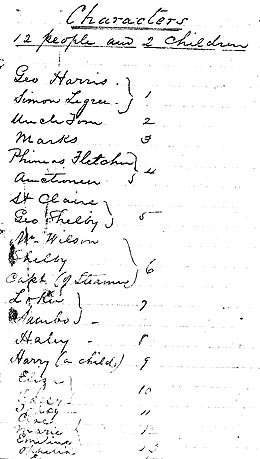 THIS CAST LIST, THE FIRST PAGE IN THE PROMPTBOOK, SHOWS HOW A TOMMER COULD PLAY TWO OR (IN ONE CASE) THREE CHARACTERS |
|
